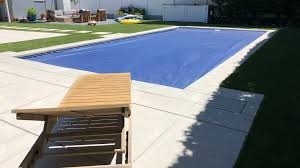Installing an inground pool cover is not just a luxury but a strategic investment that offers substantial savings on energy bills and maintenance costs. By reducing water evaporation, minimizing debris accumulation, and maintaining chemical balance, these covers can significantly decrease the time and money spent on pool upkeep.
Moreover, the enhanced protection against algae growth and chemical degradation helps in prolonging the pool’s lifespan, translating into lower long-term expenses. In this article, we will delve into the financial and practical benefits of inground pool covers, evaluating whether the upfront cost is justified by the considerable savings and convenience it provides.
Join us as we explore how this essential tool can transform your pool maintenance routine and energy consumption.
Understanding Pool Cover Investments
As you consider investing in an inground pool cover, it’s essential to understand the value of such an investment. Not only do these covers offer immediate savings on energy and maintenance costs, but they also provide long-term financial benefits by protecting and extending the life of your pool.
In this section, we will break down the key factors involved in a pool cover investment, equipping you with the knowledge to make an informed decision.
Cost-Benefit Analysis
A cost-benefit analysis reveals significant potential savings when considering the investment in inground pool covers. Initially, the price of a pool cover might seem steep, but the reduction in energy consumption quickly offsets this expense.
By preventing up to 70% of water evaporation, a pool cover can save thousands of gallons of water annually. This translates into lower water bills and reduced chemical usage, as maintaining the correct chemical balance becomes easier.
Additionally, the cover minimizes debris, reducing the frequency of cleaning and the need for maintenance services. Over time, these savings accumulate, often surpassing the initial investment.
Furthermore, preserving your pool’s structural integrity by shielding it from chemical degradation and algae growth extends its lifespan. For many, these savings, combined with the convenience of reduced maintenance, make the investment in safety pool covers, including swimming pool safety covers, a financially sound decision.
Types of Pool Covers
Inground pool covers come in various types, each offering distinct advantages tailored to specific needs. Solar covers are popular for their dual purpose of minimizing evaporation and absorbing sunlight to naturally heat the pool, thereby reducing heating costs.
Mesh covers, on the other hand, are lightweight and effective in keeping out debris while allowing rainwater to drain through, simplifying water maintenance. For those prioritizing safety, solid safety pool covers provide robust protection, preventing accidental falls and blocking sunlight to inhibit algae growth. Automatic covers offer convenience with the ease of opening and closing at the touch of a button, although they require a higher initial investment.
Each type of cover addresses unique aspects of pool maintenance, from conserving energy to enhancing safety. Understanding these options helps pool owners select the best swimming pool safety covers to meet their needs while maximizing their investment’s value.
Initial Installation Considerations
When deciding to install an in-ground pool cover, several initial considerations come into play. First, the size and shape of the pool significantly impact the choice of cover. Custom-fit covers ensure maximum effectiveness in reducing evaporation and debris accumulation.
Additionally, the local climate influences the type of cover that will provide the most benefits. For instance, regions with high sun exposure might benefit more from solar covers that help maintain water temperature. Installation costs also vary based on whether you opt for professional installation or a DIY approach. Professionals ensure a precise fit and secure installation, but self-installation can reduce upfront costs.
Moreover, consider the compatibility of the cover with existing pool equipment. Automatic covers may require specific track systems, adding to the complexity. By weighing these factors, pool owners can make informed decisions, ensuring their investment in safety pool covers delivers optimal returns.
Energy Savings with Pool Covers
Energy efficiency is a critical concern for pool owners seeking to manage operational costs. Using an in-ground pool cover is a practical solution for significantly reducing heating expenses and conserving water.
This section will explore how pool covers can contribute to energy savings by minimizing heat loss and water evaporation, ultimately leading to lower energy bills and more sustainable pool maintenance. Let’s dive into the specific ways pool covers can make a substantial difference.
Reducing Heating Costs
Inground pool covers are instrumental in reducing heating costs by acting as insulating barriers. By covering the pool, heat retention is significantly improved, preventing temperature loss, especially during cooler nights. This is particularly beneficial for pools in regions with fluctuating temperatures, where maintaining a consistent water temperature typically demands more energy.
Solar covers provide an additional advantage by harnessing sunlight to naturally raise water temperatures, thus decreasing reliance on heating systems. This not only cuts down on energy consumption but also extends the lifespan of pool heaters by reducing operational demand. Studies indicate that using a pool cover can reduce heating costs by up to 50%, offering substantial savings over time.
For pool owners seeking to optimize energy efficiency, investing in swimming pool safety covers that offer both insulation and solar benefits represents a smart financial decision. This approach aligns energy conservation with cost-effectiveness, delivering dual benefits.
Minimizing Water Evaporation
One of the primary benefits of inground pool covers is their ability to minimize water evaporation. Uncovered pools can lose up to 1/4 inch of water each day due to evaporation, leading to significant water waste over time.
By acting as a physical barrier, pool covers dramatically reduce water loss, helping to conserve water resources and lower water bills. This is particularly crucial in areas experiencing water shortages or drought conditions.
In addition to saving water, reducing evaporation maintains the chemical balance of the pool, as fewer chemicals are lost with the evaporating water. This ensures a more stable pool environment and decreases the frequency of chemical additions, which can be costly.
For pool owners, utilizing safety pool covers effectively addresses evaporation concerns while simultaneously cutting down on maintenance efforts and expenses. Thus, minimizing evaporation not only conserves water but also optimizes the overall efficiency of pool management.
Maintenance Cost Reductions
Taking care of a pool can become costly when you consider routine maintenance and the need for various chemicals. However, using inground pool covers can notably reduce these expenses by preserving essential pool chemistry and keeping debris at bay.
In this section, we’ll explore how these covers can lower maintenance costs, offering insights into efficient pool management and how they contribute to a cleaner, more cost-effective swimming environment.
Lower Chemical Usage
Inground pool covers play a crucial role in reducing chemical usage, directly impacting maintenance costs. By limiting water evaporation, these covers help maintain the pool’s chemical balance more effectively.
When water evaporates, essential chemicals like chlorine evaporate with it, necessitating frequent replenishments. Covering the pool reduces this chemical loss, ensuring that the pool remains sanitized with fewer adjustments. This not only lowers the cost of purchasing chemicals but also cuts down on the labor involved in maintaining chemical levels.
Additionally, by blocking debris and sunlight, pool covers inhibit algae growth, which can otherwise require significant chemical intervention to manage. Fewer algae problems mean less need for algaecides and clarifiers, further reducing chemical expenses. For pool owners, investing in swimming pool safety covers is a strategic decision that streamlines maintenance efforts and minimizes chemical-related costs, contributing to overall efficiency and sustainability in pool care.
Debris Protection and Cleaning
Inground pool covers offer excellent protection against debris, significantly reducing the time and effort required for cleaning. Leaves, twigs, and other debris can quickly accumulate in an uncovered pool, leading to clogged filters and increased wear and tear on pool equipment.
By acting as a barrier, pool covers prevent debris from entering the water, keeping it cleaner for longer periods. This means fewer hours spent skimming the surface and vacuuming the pool floor, allowing for more enjoyable swim time. Additionally, keeping debris out of the pool helps maintain water clarity and reduces the need for frequent backwashing of filters, which can save on water and maintenance costs.
For pool owners, the investment in safety pool covers translates into less manual labor and lower maintenance expenses. Overall, debris protection provided by pool covers enhances the swimming experience and contributes to the longevity of the pool’s filtration system.
Final Thoughts
In summary, inground pool covers offer a multitude of benefits that make them a worthwhile investment for any pool owner. From significant reductions in energy bills and maintenance costs to the extension of your pool’s lifespan, the advantages are clear and compelling. By curbing water evaporation, maintaining chemical balance, and safeguarding against debris, these covers not only enhance the efficiency and sustainability of your pool but also provide peace of mind and convenience.
As you contemplate the initial expense, it’s important to consider the long-term savings and the ease they bring to pool maintenance. The right pool cover can transform your maintenance routine and provide substantial cost savings, making it a strategic addition to your pool care toolkit.
Ultimately, investing in an in-ground pool cover is a decision that pays off in more ways than one, offering both immediate and lasting benefits. We hope this detailed exploration has equipped you with the insights needed to make an informed decision that aligns with your financial and practical needs. Happy swimming!



